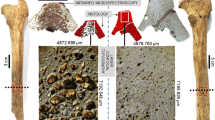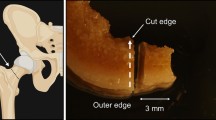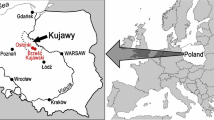Abstract
THE pliability of human bone decreases with increasing age, and the incidence of bone fracture increases after about 35 years of age. These changes indicate that some structural changes occur in bone over a lifetime. Much work has been done on the correlation between the histological components of bone and its physical properties, and their variation with age, but contradictory conclusions have been drawn1,2. No attempt seems to have been made to correlate the physical properties of bone with the physical and chemical nature of bone mineral, although it has been claimed that fracture occurs chiefly at “cement lines”2. Because the chemical nature of bone mineral, that is apatite, does not undergo any appreciable change during a lifetime, it can be inferred that the changes probably occur in the physical properties of the apatite crystals; for example, size and shape or their relative arrangement in space. Robinson and Watson3 claimed from their electron microscopy that crystallites of bone apatite increase in size with age. But their experimental technique—sectioning of bone with a glass knife, use of silica-coated collodion-covered grids, and subsequent deliberate heating of the specimen grids—makes their results difficult to interpret, especially in view of recent observations that the process of sectioning may deform and/or shatter the crystallites4. Robinson and Watson did not try to correlate their observations with the physical properties of bone, although they observed that senile bone was difficult to section.
This is a preview of subscription content, access via your institution
Access options
Subscribe to this journal
Receive 51 print issues and online access
$199.00 per year
only $3.90 per issue
Buy this article
- Purchase on Springer Link
- Instant access to full article PDF
Prices may be subject to local taxes which are calculated during checkout
Similar content being viewed by others
References
Sedlin, E. D., and Hirsch, C., Acta Orthop. Scandinav., 37, 29 (1966).
Evans, F. G., and Bang, S., Amer. J. Anat., 120, 79 (1967).
Robinson, R. A., and Watson, M. L., Ann. NY Acad. Sci., 60, 596 (1955).
Towe, K. M., and Hamilton, G. H., J. Ultra. Res., 22, 274 (1968).
Chatterji, S., and Jeffery, J. W., Nature, 214, 559 (1967).
Mamedov, H. S., Chatterji, S., and Jeffery, J. W., Indian Concrete J., 42, 66 (1968).
Atkinson, P. J., and Weatherell, J. A., J. Bone and Joint Surgery, 49 B, 781 (1967).
Gwatkin, R. B. L., and Thomson, J., Nature, 201, 1242 (1964).
Kuhn, K., and Eggl, M., Biochemisch Zeitschr., 344, 215 (1966).
Author information
Authors and Affiliations
Rights and permissions
About this article
Cite this article
CHATTERJI, S., JEFFERY, J. Changes in Structure of Human Bone with Age. Nature 219, 482–484 (1968). https://doi.org/10.1038/219482b0
Received:
Revised:
Issue Date:
DOI: https://doi.org/10.1038/219482b0
This article is cited by
-
Skeletal age determination by nandibular histomorphometry
International Journal of Anthropology (1990)
-
Age-related changes in the tensile creep properties of human compact bone tissue
Mechanics of Composite Materials (1982)
-
Age-related changes in the orientation and particle size of the mineral phase in human femoral cortical bone
Calcified Tissue International (1981)
-
Age-related changes in mechanical indices of compact bone tissue
Mechanics of Composite Materials (1980)
-
Evaluation of some deformation and strength characteristics of compact bone tissue according to the data of a biochemical study
Polymer Mechanics (1977)
Comments
By submitting a comment you agree to abide by our Terms and Community Guidelines. If you find something abusive or that does not comply with our terms or guidelines please flag it as inappropriate.



